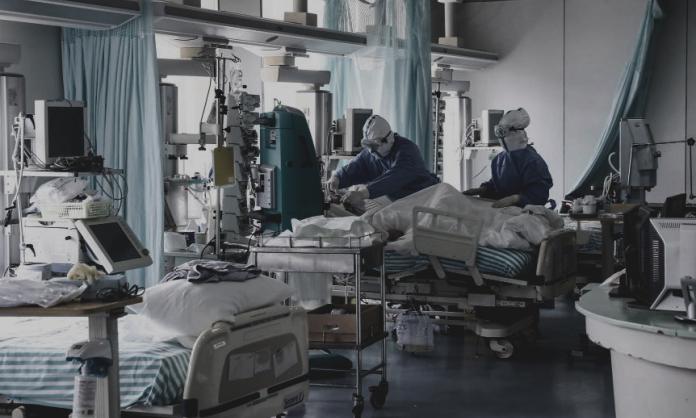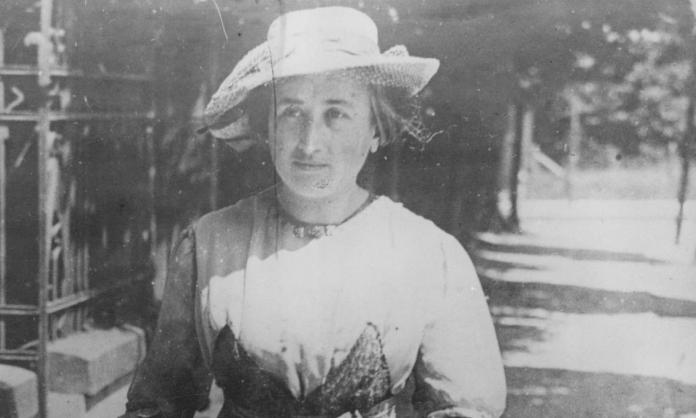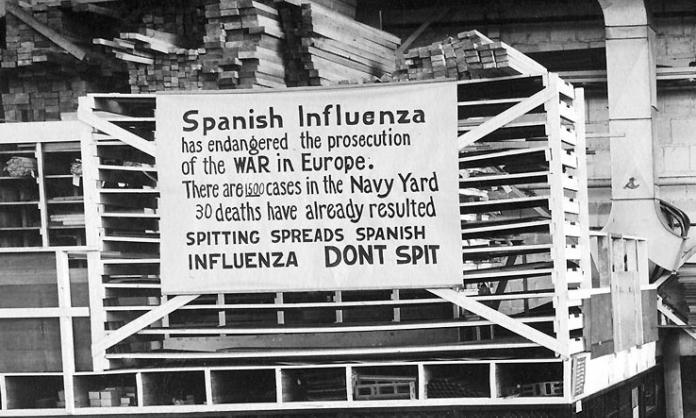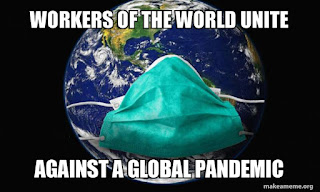Corey Oakley 29 April 2020 RED FLAG AU.

Australia may or may not have done enough, at least for now, to suppress the COVID-19 threat and prevent a health catastrophe along the lines of those currently unfolding in the US, Europe and much of the rest of the world. But whatever happens on the health front, there is no escape from the global economic catastrophe, which will upend economic and social life in Australia for years to come.
Mass unemployment, savage cuts to wages and conditions, the wiping out of superannuation funds that millions rely on for retirement, the destruction of tens of thousands of businesses – all these things are now unavoidable. We are entering a global economic meltdown at least as severe as the Great Depression, and one which, in terms of its basic dynamic, has no precedent in the history of capitalism. Nothing is going back to normal.
Australia escaped the worst of the 2008 financial crisis. There will be no escape this time. Every aspect of the globalised world economy is being upended. The world trading system is collapsing. Supply chains everywhere are breaking. Whole industries have become unviable overnight. Of the vast number of businesses closing their doors, a huge number will never reopen. The world as we knew it is gone, and what emerges from this crisis will be almost unrecognisable – socially, economically and politically.
In this context, what should socialists and the left propose?
There is a strain of thought on the left that the crisis, demonstrating as it does the absolute catastrophic failure of capitalism in its current form, will organically open the road to a new social democratic moment – one in which the world agrees that we need to replace unbridled market policies with a new system of social ownership, nationalised industry and production for use rather than profit.
If only it were so simple. The capitalist class, as it has done in every crisis in the history of the system, will fight to defend its power at all costs. This may mean enormous transformations of the way the economy works. In World War Two, it wasn’t just the USSR that had a command economy. Western Governments also took control of huge swathes of industry from private capitalists and repurposed them to serve the war machine. This transformed economies, but not in the interests of workers. The ideology of the market and the short-term interests of individual capitalists were sacrificed to maintain the national capitalist system.
Today, the institutional and ideological decay of world capitalism is far more advanced than during the crises that spawned the two world wars. The United States is the greatest military and economic power the world has ever known, but also a political basket case whose political parties and state and civil institutions are in permanent disarray and held in contempt by the mass of the population.
The system would be doomed if it were not for its one great advantage – the devastating political weakness and lack of organisation of the working class. The ruling class of the West may not be able to establish a positive political authority, but in the face of working class passivity and the corrupt and conniving complicity of the institutions of working class politics – most importantly the trade unions – it can continue to implement policies that enrich the tiny minority at the top while leaving the rest of us to rot.
As this crisis unfolds, that will continue to be its modus operandi. Look after profits, even if you have to bleed the country dry. Look after the rich, even if you have to abandon every market policy you claimed was sacred. In the coming months and years there will be a huge battle between those sections of capital that want to hold onto the idea of the free market at all costs, and those that recognise the necessity of massive state intervention if capital as a whole is to be saved.
But that contest will be nothing compared to the war the bosses will wage on the rest of us to make sure that, however the economy is reorganised, workers are made to pay for it. The job of the left is to build an alternative pole, one that champions the interests of workers and students and pensioners and the millions of unemployed workers that the system is currently throwing on the scrap heap.
What demands would such a movement take up? First, to take the market and the profit motive and money out of as much of the economy as possible. Basic human needs must be met as a human right. This means a total rethinking of the way the economy is organised. We should demand a complete government takeover of all basic services and insist they all be delivered for free.
For decades, governments of all stripes have tried to turn child care and education into user-pays institutions, claiming that parents and kids are the beneficiaries and therefore should pay all the costs. The coronavirus crisis has made it crystal clear that the capitalist system relies on the child care and schooling system both to raise the next generation of workers and to enable the current generation to work. Scott Morrison essentially admitted this when he made the unilateral decision to make child care free for the duration of the crisis. Child care should be a public system like the public schools.
The health sector has not been as hard hit as it might have been (and still could be) by COVID-19, but the experience is a warning about how disastrous the health care-for-profit model is. In a crisis, it becomes obvious that governments should take command of all health care facilities. That is what has happened in Victoria and elsewhere in recent weeks. But we shouldn’t be paying private hospitals to rent their beds and equipment and staff. We should be taking them over and integrating them into the public system. In the best of times, a dual system of public and private health means people with more money have more right to live. That’s obscene. In a health crisis, all an independent private system means is that the capacity of the system as a whole to respond is hampered by private interests.
The area of health care omitted from general discussion is aged care. This almost totally privatised sector is notorious for abusing its residents and exploiting its staff. It needs to be immediately nationalised, moved into the public health system and held to the same standards as hospitals, rather than be treated as “waiting to die” wards.
All utilities need to be nationalised or renationalised. Gas and electricity were once publicly owned. They should be again. The decades-long experiment with privatisation has been a disaster. Now, the coronavirus crisis exacerbates it. Not only should these utilities be renationalised, but all bills for consumers should be abolished. No one should have to think about whether they can afford to turn on a heater in winter because they don’t know if they can pay a bill. No one should have to forgo food because they know a utility bill is due. Internet and mobile phone data are now also basic essential utilities. They should be provided to everyone, free of charge. Access to the internet or the ability to make a phone call should not depend on your income.
Public transport should be taken back into public hands and made free. Trams, trains and buses are running almost empty. They run because the government says they have to, and they are paying millions to private companies to do it. Why? These are public services that need to be provided regardless of whether they turn a profit. They should be taken out of the sphere of the market and run to service the public, not make money for some private corporation.
In addition to basic public services being made, once again, public services, the left should be demanding nationalisation of all unviable major industries, as opposed to government bailouts. Virgin Australia is the obvious case. Instead of handing over billions to enable a corporate outfit to take over Virgin, the government should take it over directly, and then operate it as a low cost domestic airline that has cheap fares and pays its employees well and ensures good conditions.
Just taking things into public ownership is not enough. All nationalised industries should be run with as much democratic control as possible, rather than by an elite of highly paid bureaucrats. Workers need expanded rights to organise around health and safety, to shut down sites as they see fit, organise inspections and so on.
There is also the broader issue of how to deal with the huge unemployment numbers Australia is now facing. So far, the government has raised Newstart by $550 per fortnight – good, but it should be raised to what the government implicitly admits is the lowest livable income, the $1,500 per fortnight JobKeeker payment.
But the JobKeeker payment is also being revealed to be deeply problematic. Many employers haven’t even applied for it, because keeping their workers’ heads above water doesn’t help their bottom line. Others are exploiting it in various ways. Some small businesses can’t afford it because the government payment kicks in a month after payments are due, or they don’t want to pay in advance because they aren’t sure if they will meet the eligibility requirements.
What the left should be demanding instead is a government job guarantee. $1,500 a fortnight is a pretty pitiful amount – if the CEOs were being thrown on the scrap heap like workers are, it would be many times higher. So a government job guarantee should offer a higher basic wage. But the essential thing is that instead of tying each worker to the whim of their current employer, the government should be saying to every unemployed worker: we will give you an income, and if we can, we will give you a job.
It might not be possible overnight for the government to employ every person who has lost their job, but over time it would be easy. A massive expansion of spending on schools, health care, child care, aged care etc. would require a lot more jobs. The government could start a huge public works program of railways, tunnels, local infrastructure etc. – the kind of things that have been farmed out to the private sector in the past, but which could now be undertaken directly by governments employing thousands of people on proper wages and with decent conditions that could then be generalised across industries such as construction. A government-run public works program could encompass so many socially necessary things, retooling industry to deal with the COVID-19 crisis, but also reorganising the economy to deal with the ongoing climate crisis.
How would you pay for all this? Most discussions of this issue start with a massive blunder – they conflate the ability of society to pay for something with the question of whether the market would like it in the current context. But this relies on the old economics that the coronavirus experience has exposed as meaningless. The truth is, an economy can produce as much as its productive forces allow. It can distribute the goods it produces according to its technological and logistical capacity. These things have nothing to do with the market or prices. The conviction that they do is ideology – the ideology that in normal times makes us accept the fact that yes, there are lots of homeless people, and yes, there are lots of empty homes, but it is acceptable that the homeless people not be given the empty homes because that would break the economy.
Well now, every day, things are being done that break the economic model far more than giving a few alms to the poor ever would have. These extraordinary measures are being taken to save the profit system. The only reason transformative measures cannot be taken to maintain and improve the living standards of the vast majority and end the vicious income and wealth inequality that has marked the past 40 years is the political outlook of our political rulers. We need to build a left that can challenge them on every level, fighting for our rights in workplaces, but also putting forward a vision of how society could be reorganised in the interests of the vast majority.
















